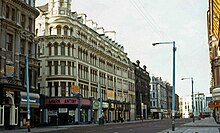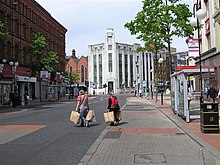Royal Avenue, Belfast

Royal Avenue is a street in the heart of
Location

Beginning from the Donegall Place junction with Castle Place and Castle Street, which is the hub of Belfast city centre, the road runs north to the North Street crossing where the former Bank of Ireland once stood. A fire in summer of 2018 caused the front part of the building to burn leaving only the back of the building standing. Royal Avenue then angles northeast to the Donegall Street intersection continuing in a northeasterly direction as York Street.
Looking south on Royal Avenue, there is an imposing vista of
History

This section needs additional citations for verification. (October 2015) |
The upper part was formerly named John Street, and the lower part was named Hercules Street after Sir Hercules Langford.[1] Royal Avenue was established in 1881.[1] Since that time, it has served as Belfast's principal shopping thoroughfare, and today it is lined with many leading department stores and top name shops.
The city's most prestigious and elegant hotel, the
Royal Avenue was filmed from a horse-drawn
On 29 October 1935, Royal Avenue was packed with thousands of mourners as the funeral cortege of Edward Carson made its way along the street. The road was hit by bombs in the Belfast Blitz when the German Luftwaffe bombarded the city on the night of 15/16 April 1941 in an aerial attack that involved up to 200 bombers and lasted for six and a half hours; many of the buildings sustained considerable damage, although the destruction was much less severe than what was wrought in nearby Donegall and York streets. The Germans returned to bombard the city in another raid on the night of 4/5 May. Royal Avenue was spared from the excessive damage visited upon adjacent streets which were gutted by fire. It is one of the traditional routes used by the Orange Order on their annual 12 July parade.[citation needed]
The Troubles

Throughout the Troubles, Royal Avenue was targeted by the Provisional IRA due to its economic importance as a commercial zone and the presence of the British Army military barracks. The barracks itself was bombed many times in the mid-1970s, despite the anti-rocket metal mesh put up to fortify the edifice.[3] Security gates placed at the junction of Royal Avenue and Donegall Place were closed every evening at 6:00 p.m., sealing off the area by what was known locally as a "ring of steel".[3]
On 25 November 1975 when Francis Crossan, a 34-year-old Catholic civilian, was abducted by the notorious
On 24 February 1988 two Ulster Defence Regiment (UDR) soldiers, James Cummings and Fred Starrett, were killed when a 200-pound remote-controlled IRA bomb, hidden behind hoardings on a construction site, detonated at a Royal Avenue security gate manned by the UDR. The blast caused considerable damage to the area surrounding the bomb site.[7]
Royal Avenue was yet again attacked by the IRA on 1 January 1993 when an explosive device containing one pound of Semtex was left inside a hairdresser's salon but the device was successfully defused.[8]
Royal Avenue today

Royal Avenue is one of the main commercial centres in Belfast. Shops currently on the street include branches of
The centre occupies the former site of the Grand Central Hotel.The ornate building at 2 Royal Avenue was the former home of the Provincial Bank of Ireland which was erected in 1869.[10] After its closure in 1989, the building was occupied until 2021 by a Tesco store.[11] It was then refurbished as a social facility by Belfast City Council.[12] Next door at 4 Royal Avenue is located the Ulster Reform Club. It was established in 1982 through a merger of the Ulster and Reform clubs, but, tracing its roots through the latter organisation back to 1880.[13]
The Art Deco building at the junction of North Street and Royal Avenue, which was formerly the headquarters of the Bank of Ireland before being left derelict, was taken over by the Occupy movement in early 2012.[14] They since took to referring to the building as the "People's Bank".[15] The group left the building ten months later.[16]
Around 2008 calls came from certain quarters, including former
References
- ^ a b "Belfast History Through the Years". Rushlight Magazine
- ^ a b Chartres, John; Henshaw, Bert; Dewar, Michael (1986). Northern Ireland Scrapbook. London: Arms and Armour Press. p.65
- ^ a b c d e "The Grand Central Hotel, Royal Avenue" Archived 13 February 2012 at the Wayback Machine. Richard Graham. 6 November 2008.
- ^ Sutton Index of Deaths 1975.
- ^ Dillon, Martin (1989). The Shankill Butchers: the real story of cold-blooded mass murder. New York: Routledge. p. 55
- ^ Martin Dillon, The Trigger Men, Mainstream Publishing, 2003, p. 160
- ^ O'Brien, Brendan (1995). The Long War: The IRA and Sinn Féin. Dublin: O'Brien Press. p. 263
- ^ List of Castle Court stores.
- ^ "1869 - Former Bank". archiseek. 23 September 2009. Retrieved 6 September 2022.
- ^ "10 of Britain's best listed supermarkets". the spaces. 30 September 2015. Retrieved 23 June 2020.
- ^ "2 Royal Avenue". Belfast City Council. Retrieved 6 September 2022.
- ^ Ulster Reform Club.
- ^ Occupy Belfast protesters at bank may get a visit from council inspectors.
- ^ Belfast Building Becomes "The People’s Bank", belfasttelegraph.co.uk; accessed 17 October 2015.
- ^ Occupy Belfast protesters quit building after near-tragedy in street, belfasttelegraph.co.uk; accessed 17 October 2015.
- ^ Latest city centre accident sparks call for pedestrian zone.

